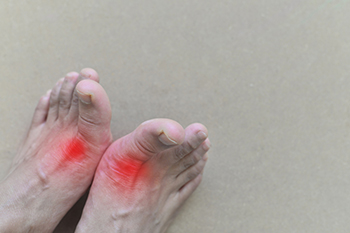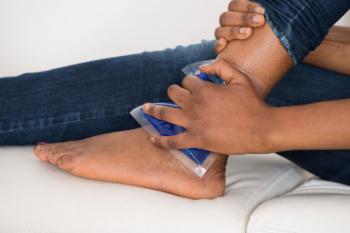Connect With Us
Blog

Gout is a painful inflammatory condition that often strikes the big toe and can appear suddenly with intense redness, swelling, and warmth that makes even light contact uncomfortable. The attacks may feel like burning pressure or sharp throbbing, and the joint may look shiny or purple as uric acid crystals irritate the tissue. Gout is commonly caused by elevated uric acid levels linked to genetics, diet, certain medications, or underlying medical conditions. A podiatrist can assist from the very beginning by performing a careful examination, ordering appropriate tests, and distinguishing gout from other foot disorders. Early diagnosis allows timely treatments that may include medication to reduce inflammation, guidance on footwear, custom orthotics to ease joint stress, in addition to long-term strategies to prevent future flare ups through lifestyle adjustments. Because prompt care can significantly reduce pain and protect joint health, it is suggested that you schedule an appointment with a podiatrist who can help you to manage this painful condition,
Gout is a painful condition that can be treated. If you are seeking treatment, contact Keleigh Muxlow, DPM from Colorado. Our doctor will treat your foot and ankle needs.
What Is Gout?
Gout is a form of arthritis that is characterized by sudden, severe attacks of pain, redness, and tenderness in the joints. The condition usually affects the joint at the base of the big toe. A gout attack can occur at any random time, such as the middle of the night while you are asleep.
Symptoms
- Intense Joint Pain - Usually around the large joint of your big toe, and it most severe within the first four to twelve hours
- Lingering Discomfort - Joint discomfort may last from a few days to a few weeks
- Inflammation and Redness -Affected joints may become swollen, tender, warm and red
- Limited Range of Motion - May experience a decrease in joint mobility
Risk Factors
- Genetics - If family members have gout, you’re more likely to have it
- Medications - Diuretic medications can raise uric acid levels
- Gender/Age - Gout is more common in men until the age of 60. It is believed that estrogen protects women until that point
- Diet - Eating red meat and shellfish increases your risk
- Alcohol - Having more than two alcoholic drinks per day increases your risk
- Obesity - Obese people are at a higher risk for gout
Prior to visiting your podiatrist to receive treatment for gout, there are a few things you should do beforehand. If you have gout you should write down your symptoms--including when they started and how often you experience them, important medical information you may have, and any questions you may have. Writing down these three things will help your podiatrist in assessing your specific situation so that he or she may provide the best route of treatment for you.
If you have any questions, please feel free to contact our office located in Littleton, CO . We offer the newest diagnostic and treatment technologies for all your foot care needs.

Anterior tarsal tunnel syndrome is a condition caused by compression of the deep peroneal nerve as it passes under the structures on the top of the foot. This compression can result from wearing tight shoes, repetitive activity, trauma, or swelling in the area. Symptoms include tingling, numbness, burning, or sharp pain between the first and second toes, as well as discomfort on the top of the foot that may worsen with activity or footwear pressure. Risk factors include engaging in activities that place repeated stress on the foot, wearing improperly fitting shoes, or having structural foot abnormalities. A podiatrist can diagnose the condition using a physical exam and imaging if needed, as well as recommend supportive footwear, orthotics, or anti inflammatory therapy. If you have pain in this part of your foot, it is suggested that you consult a podiatrist who can accurately diagnose and treat the condition.
Tarsal tunnel syndrome can be very uncomfortable to live with. If you are experiencing tarsal tunnel syndrome, contact Keleigh Muxlow, DPM of Colorado. Our doctor can provide the care you need to keep you pain-free and on your feet.
Tarsal Tunnel Syndrome
Tarsal tunnel syndrome, which can also be called tibial nerve dysfunction, is an uncommon condition of misfiring peripheral nerves in the foot. The tibial nerve is the peripheral nerve in the leg responsible for sensation and movement of the foot and calf muscles. In tarsal tunnel syndrome, the tibial nerve is damaged, causing problems with movement and feeling in the foot of the affected leg.
Common Cause of Tarsal Tunnel Syndrome
- Involves pressure or an injury, direct pressure on the tibial nerve for an extended period of time, sometimes caused by other body structures close by or near the knee.
- Diseases that damage nerves, including diabetes, may cause tarsal tunnel syndrome.
- At times, tarsal tunnel syndrome can appear without an obvious cause in some cases.
The Effects of Tarsal Tunnel Syndrome
- Different sensations, an afflicted person may experience pain, tingling, burning or other unusual sensations in the foot of the affected leg.
- The foot muscles, toes and ankle become weaker, and curling your toes or flexing your foot can become difficult.
- If condition worsens, infections and ulcers may develop on the foot that is experiencing the syndrome.
A physical exam of the leg can help identify the presence of tarsal tunnel syndrome. Medical tests, such as a nerve biopsy, are also used to diagnose the condition. Patients may receive physical therapy and prescriptive medication. In extreme cases, some may require surgery.
If you have any questions please contact our office located in Littleton, CO . We offer the newest diagnostic and treatment technologies for all your foot and ankle needs.

A dislocated ankle occurs when the talus, the main ankle bone, is pushed out of place from under the tibia and fibula, which are the bones of the lower leg. This sudden shift causes sharp pain, swelling, and a foot that looks out of alignment. The injury also affects the ligaments that hold the ankle steady, as well as nearby joints where the talus meets the calcaneus, or heel bone. A podiatrist can check the position of the foot, make sure blood flow and feeling in the toes are normal, and use imaging to see if any nearby bones have been damaged. Treatment focuses on gently guiding the talus back into place and keeping the ankle immobile so healing can start. Surgery may be considered when there are fractures or if the ankle remains unstable. If you believe you have dislocated your ankle, it is suggested that you make an appointment with a podiatrist for a diagnosis and treatment options.
Ankle pain can be caused by a number of problems and may be potentially serious. If you have ankle pain, consult with Keleigh Muxlow, DPM from Colorado. Our doctor will assess your condition and provide you with quality foot and ankle treatment.
Ankle pain is any condition that causes pain in the ankle. Due to the fact that the ankle consists of tendons, muscles, bones, and ligaments, ankle pain can come from a number of different conditions.
Causes
The most common causes of ankle pain include:
- Types of arthritis (rheumatoid, osteoarthritis, and gout)
- Ankle sprains
- Broken ankles
- Achilles tendonitis
- Achilles tendon rupture
- Stress fractures
- Bursitis
- Tarsal tunnel syndrome
- Plantar fasciitis
Symptoms
Symptoms of ankle injury vary based upon the condition. Pain may include general pain and discomfort, swelling, aching, redness, bruising, burning or stabbing sensations, and/or loss of sensation.
Diagnosis
Due to the wide variety of potential causes of ankle pain, podiatrists will utilize a number of different methods to properly diagnose ankle pain. This can include asking for personal and family medical histories and of any recent injuries. Further diagnosis may include sensation tests, a physical examination, and potentially x-rays or other imaging tests.
Treatment
Just as the range of causes varies widely, so do treatments. Some more common treatments are rest, ice packs, keeping pressure off the foot, orthotics and braces, medication for inflammation and pain, and surgery.
If you have any questions please feel free to contact our office located in Littleton, CO . We offer the newest diagnostic tools and technology to treat your foot and ankle needs.

